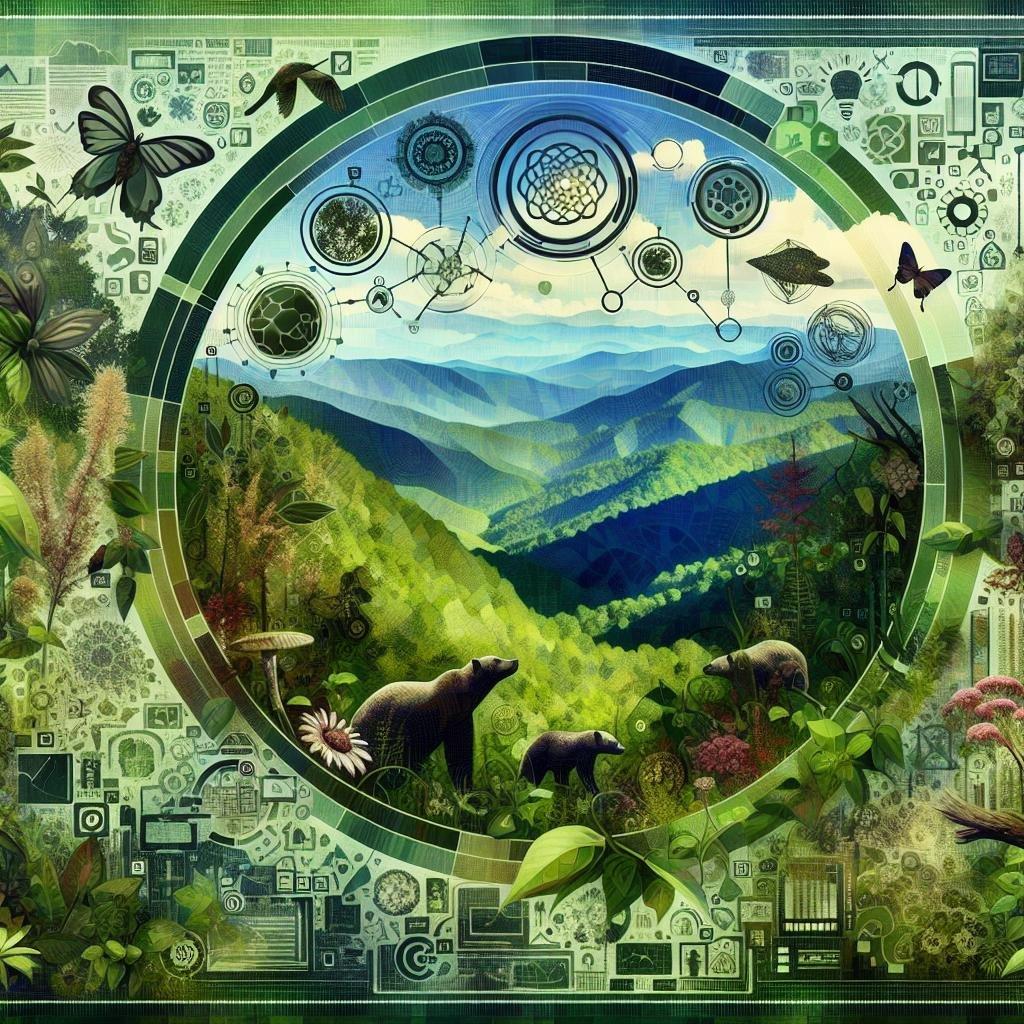Nestled at the doorstep of the Great Smoky Mountains, Gatlinburg is more than just a gateway to stunning vistas; it’s a vibrant tapestry of life that beckons nature enthusiasts and curious minds alike. As the sun breaches the horizon, painting the skies with hues of dawn, the trails that wind through Gatlinburg’s rich landscape come alive with wonders waiting to be discovered. From the whispering pines standing sentinel over centuries-old paths to the melodious chorus of diverse bird species, Gatlinburg’s hiking trails are a testament to the intricate dance of biodiversity and ecology. This article delves into the allure of these trails, exploring how they offer not only a refuge for myriad forms of life but also an opportunity to understand the delicate balances that sustain them. Join us as we wander along these paths, where each step reveals a new chapter in the story of nature’s resilience and beauty.
Discovering Hidden Species along Gatlinburgs Trails
Amidst the lush vegetation and serene beauty of Gatlinburg’s trails lies a spectacular showcase of biodiversity waiting to be discovered. As you meander through the breathtaking pathways, keep an eye out for the rare and elusive creatures that thrive here, away from the usual hiking crowds. From the subtle rustle of wings to the fleeting shadows in the canopy, this region is home to both endemic and migratory species that contribute to the rich ecological tapestry. However, these hidden gems demand patience and a keen eye. It’s not uncommon to spot the elusive blue ghost firefly, whose soft glow dances along the forest floor, or hear the unique call of the red-eyed vireo, often described as the forest’s whisperer.
For the curious explorer, Gatlinburg’s trails offer a chance to delve deeper into the ecosystems and learn about the distinct habitats that nurture these species. From dense woodlands to cool mountain brooks, each environment supports a niche community, fostering a web of life that is both fragile and resilient. Key species you might encounter include:
- Eastern Box Turtle – Prefers moist forest floors and is known for its vibrant shell patterns.
- Appalachian Cottontail – A shy resident of higher elevations, often mistaken for its more common cousin, the eastern cottontail.
- Spotted Salamander – Often found under logs or in damp areas, famous for its striking yellow spots.
| Species | Habitat | Notable Feature |
|---|---|---|
| Blue Ghost Firefly | Forest Floor | Continuous soft glow |
| Red-eyed Vireo | Mixed Woodlands | Distinctive melodic call |

The Role of Local Flora in Trailside Ecosystems
Along the picturesque hiking trails of Gatlinburg, the local flora plays a monumental role in maintaining the intricate balance of the ecosystem. From the towering canopies of oak and maple trees to the lush undergrowth of ferns and wildflowers, each plant species contributes uniquely to the web of life. These green companions provide not only shade and beauty but also serve as vital food and shelter for countless creatures. For instance, the red trillium attracts pollinators such as bees and butterflies, while the American beech offers its nuts as sustenance to birds and small mammals. Understanding these connections is crucial for hikers as they tread lightly and acknowledge the flora’s fundamental contribution to biodiversity.
Local plant life is not just about individual species but also about the dynamic interactions within the community. The symbiotic relationships between the flora, fungi, and fauna foster a thriving habitat. Look closely, and you’ll notice how mosses aid in soil stabilization, preventing erosion and providing a home for micro-ecosystems. Key Flora Components often seen on Gatlinburg’s trails include:
- Eastern Hemlock – Helps regulate stream temperature.
- Mountain Laurel – Prospers in acidic soils.
- Dogwood – Known for its springtime blooms and autumn berries.
| Plant Species | Ecological Role |
|---|---|
| Rhododendron | Shelter for small wildlife |
| Sassafras | Root support and soil enrichment |
| Pine | Habitat for birds and insects |

Trail Tips: Enhancing Your Ecological Knowledge
Wandering through the scenic trails of Gatlinburg offers you a mesmerizing insight into the vast biodiversity that thrives in this region. To truly appreciate the ecological tapestry, consider sharpening your observational skills as you hike. Start by identifying various plant species you’ll encounter. From the towering Eastern Hemlocks to the delicate Mountain Laurels, each plant plays a vital role in the ecosystem. Pay attention to their leaves, flowers, and stem structures which can foster a deeper understanding of their unique adaptations.
- Mosses and Ferns: Look under trees and near streams for these ancient plants thriving in moist environments.
- Colored Wildflowers: Discover the vibrant patches scattered throughout the trail. Each bloom tells a seasonal story.
- Old-Growth Trees: Recognize the elders of the forest with their massive trunks and sprawling branches.
The Gatlinburg trails are also a sanctuary for a myriad of wildlife, and spotting these creatures requires patience and a bit of quietude. Birds like the vibrant Scarlet Tanager or the elusive Timber Rattlesnake can add an element of wonder to your journey. Time of day affects animal visibility, with dawn and dusk being peak activity periods. It’s beneficial to educate yourself on animal behaviors and calls, enhancing your trail experience. Consider taking along a small notepad to record your sightings or sketch the creatures you encounter.
| Animal | Best Time to Spot | Unique Attribute |
|---|---|---|
| Scarlet Tanager | Early Morning | Bright Red Plumage |
| Timber Rattlesnake | Late Afternoon | Distinct rattle sound |
| White-tailed Deer | Dusk | Graceful Antlers |

Preservation Practices for Maintaining Trail Biodiversity
In order to sustain the rich tapestry of life along Gatlinburg’s hiking trails, it is essential to implement comprehensive preservation strategies. One key practice includes minimizing trail widening, which can be achieved through the installation of informative signs that encourage hikers to stay on designated paths. By doing so, the footprint left by adventurers is reduced, thereby safeguarding the surrounding flora and fauna. Additionally, introducing barriers made of natural materials such as logs or stones helps channel foot traffic while blending harmoniously into the environment. Moreover, regular monitoring of vegetation health and implementing controlled intensity burns can maintain ecosystem balance and curtail invasive species growth.
Simple steps can significantly contribute to the collective effort of maintaining biological diversity on trails:
- Engage with local environmental groups to participate in trail clean-ups and restoration projects.
- Educate fellow hikers on the importance of ”Leave No Trace” principles.
- Carry out waste, including biodegradable scraps, as they can disturb native wildlife.
| Practice | Benefit |
|---|---|
| Signage and Awareness | Educates hikers, reduces unintentional damage |
| Trail Barriers | Controls foot traffic, protects vegetation |
| Monitoring and Burns | Prevents invasive species, ensures ecosystem health |
Q&A
Exploring the Biodiversity and Ecology of Hiking Trails in Gatlinburg: Your Questions Answered
Q1: What makes the biodiversity in Gatlinburg’s hiking trails unique?
A1: Gatlinburg’s hiking trails are nestled within the Great Smoky Mountains, a UNESCO World Heritage Site and one of the most biodiverse regions in North America. This area’s unique ecology is attributed to its ancient mountains, varying elevations, and extensive forest cover, which create a myriad of habitats for a wide range of plant and animal species. From vibrant wildflowers to elusive black bears, each trail offers a diverse tapestry of life waiting to be explored.
Q2: Which trail should I choose if I’m interested in experiencing the region’s flora?
A2: For enthusiasts of vibrant foliage and unique plant life, the Porters Creek Trail is a must-visit. Especially stunning in spring, this trail showcases a spectacular array of wildflowers, including trilliums, violets, and jack-in-the-pulpits. The trail meanders through lush forests and past historic farmsteads, providing a rich tapestry of botanical beauty.
Q3: Are there any particular trails known for wildlife watching?
A3: The Cades Cove Loop is renowned for its wildlife viewing opportunities. This valley is a hotspot for spotting white-tailed deer, turkey, and occasionally black bears. With open fields surrounded by dense forests, Cades Cove offers a perfect blend of scenic beauty and abundant wildlife, making it a favorite for nature photographers and animal lovers alike.
Q4: How can I contribute to the preservation of these trails while hiking?
A4: Responsible hiking is key to preserving Gatlinburg’s trails. Simple practices like staying on designated paths, carrying out all trash, and not disturbing wildlife go a long way. Additionally, respecting trail closures and participating in local conservation efforts can help maintain the ecological integrity of the area for future generations.
Q5: What ecological challenges do the Gatlinburg hiking trails currently face?
A5: Gatlinburg’s trails face several environmental challenges, including the impacts of climate change, invasive species, and human foot traffic. Increased temperatures and erratic weather patterns can affect the delicate balance of the local ecosystems. Invasive species, such as the hemlock woolly adelgid, threaten native flora and fauna. Park management is actively working on strategies to mitigate these issues, but visitor awareness and cooperation are crucial in these efforts.
Q6: Are guided tours available for those interested in an educational experience?
A6: Yes, guided tours can enhance your understanding of the area’s rich biodiversity and ecological nuances. Many local organizations and park rangers offer educational hikes that delve into the history, flora, and fauna of the trails. These tours can provide valuable insights and a deeper appreciation for the natural wonders of Gatlinburg’s wild landscapes.
By immersing oneself in the Gatlinburg hiking trails, visitors can not only enjoy breathtaking scenery but also learn about the intricate ecosystems that make this region so special. Whether you’re a seasoned hiker or a curious beginner, Gatlinburg’s diverse trails offer something for everyone, and a reminder of the importance of preserving our natural world.
Wrapping Up
As the sun dips below the verdant peaks of Gatlinburg, the rich tapestry of its hiking trails comes to life in a new light, inviting both the seasoned explorer and the curious newcomer to partake in its wonders. The intricate dance of flora and fauna weaves a compelling story of resilience and adaptation, whispered through the rustling leaves and babbling brooks that wind their way through these ancient paths. Each trail offers not just a journey through nature, but also a journey into the heart of an ecosystem teeming with life. The vibrant symphony of biodiversity found here stands as a testament to the delicate balance that nature strikes in the Smoky Mountains. As you lace up your hiking boots and embark on your own quest, remember that every step taken on these trails is a step into a world where every leaf, every chirp, and every shadow plays its part in the ongoing saga of Gatlinburg’s natural heritage. In this tranquil intersection of earth and sky, may you find not only the thrill of discovery but also a profound sense of connection to the world around you.

